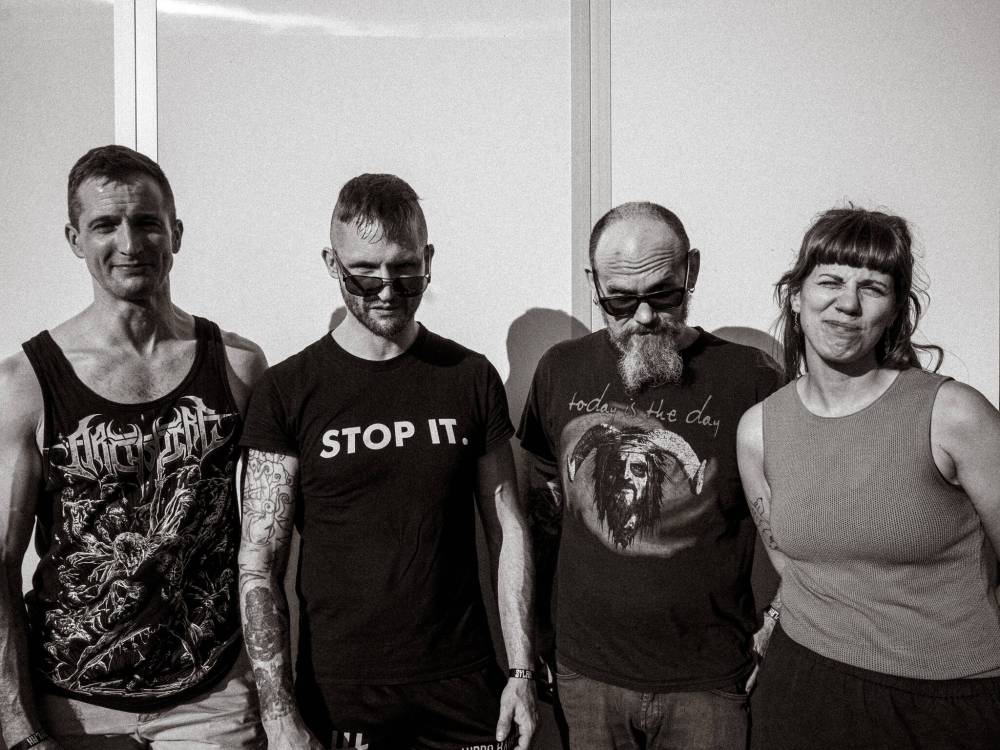KEN Mode founding members Jesse and Shane Matthewson didn’t know as kids that they’d grow up to become lifelong purveyors of dissonant, thrashing and brooding noise rock, but in retrospect, there were a few early hints. Read this article for free: Already have an account? To continue reading, please subscribe: * KEN Mode founding members Jesse and Shane Matthewson didn’t know as kids that they’d grow up to become lifelong purveyors of dissonant, thrashing and brooding noise rock, but in retrospect, there were a few early hints. Read unlimited articles for free today: Already have an account? KEN Mode founding members Jesse and Shane Matthewson didn’t know as kids that they’d grow up to become lifelong purveyors of dissonant, thrashing and brooding noise rock, but in retrospect, there were a few early hints.
“The types of toys we were drawn to as kids were always the more f—ed up ones,” says guitarist Jesse Matthewson, 41. “I always chose the bad guys. He-Man always won, so to me, they were more interesting-looking.

I guess darker versions of art and darker aspects of life were just more attractive. I don’t understand why. Maybe that’s a mental-illness thing.
I don’t know.” Supplied KEN Mode, from left: Shane and Jesse Matthewson, Skot Hamilton and Kathryn Kerr. As adolescents only beginning to seek out order amid perceived unfairness, cruelty and chaos, the Matthewsons listened to , with Nirvana’s 1993 album — produced by Steve Albini — serving as a gateway to heavier reflections on a shattered world.
After Nirvana frontman Kurt Cobain’s death, they began playing together in 1995 as the Bedlamites, later considering calling themselves the Mighty Bombula before arriving at KEN Mode — inspired by Henry Rollins’ “Kill Everyone Now” mantra — around 1998. While classmates flipped through required reading, between hockey practices, the brothers devoured , the Nirvana biography by music journalist Michael Azerrad, buying CDs by every grunge, post-hardcore and noise-rock group the author or his interviewees even mentioned in passing: the Melvins, Black Flag, Scratch Acid and Big Black. “The type of music got more and more antisocial the more I dug, and I was basically screwed from 13 on.
I could no longer relate to regular kids,” Jesse Matthewson says. That “failure” to fit into the circles of predictable behaviour became the source of the brothers’ ultimate musical shape, one defined by jagged edges and purposeful changes in direction. For 25 years, across nine full-length albums, KEN Mode has been excavating its own psyche, earning local, national and international acclaim for refusing to beautify its sound while further clarifying its initial worldview — that the darkness isn’t quite so troublesome as pretending it doesn’t exist, whether you’re sitting solo on a doomed school bus at 17 or staring down the barrel of aggrieved middle-aged disintegration on the other side of 40.
But longevity alone isn’t necessarily a reason to celebrate. As KEN Mode — currently composed of the Matthewsons, bassist Skot Hamilton and since 2017, the multi-talented saxophonist Kathryn Kerr — enters its second quarter century, the band is still discovering itself, hitting an unexpected stride as “regular” listeners begin to key in on several of the anxieties that drove the Matthewsons to first hit record. With a rotating cast of players, there have been several international tours, including a stretch, around the release of 2011’s , of what was essentially a year on the road.
Though its members have a jocular attitude toward awards recognition and mainstream acclaim, for , the band won the inaugural metal/hard music album of the year at The Junos, also earning honours from the Western Canadian Music Awards. On 2015’s followup, , the band worked with Albini himself. For their latest album, 2023’s Polaris Prize-longlisted , KEN Mode sunk into the bleakest depths of the conditions of its creation, acknowledging the viral elephant floating through the swollen air in every isolated echo chamber.
A pained, impassioned and challenging record, was well-received by critics and fans at various levels of KEN Mode familiarity. It’s music the brothers — who are also accountants, specializing in artist finances — consider a new creative peak, giving tons of credit to Hamilton and to Kerr, who also plays keys and synth, for introducing new approaches and ideas to what could at this point have become a perfunctory musical entity. “The fact that we’ve been able to pull this off, still keep doing this, have experiences like this is kind of crazy,” says Shane Matthewson.
“That some of the stuff we’re doing right now is the best it’s ever been — 25 years deep — is kind of crazy.” So, how about KEN Mode at 50? “Someone recently was talking to me about how there’s plenty of heavy bands that can continue into old age, and I was like, ‘Not drummers!’ They wear out,” says Shane. “How many more years do you guys have?” asks Kerr.
“At least two,” Jesse laughs. In reality, the band has no plans to slow down, heading on a fall tour with Chicago industrial group Hide after playing a 25th anniversary show Saturday at the Handsome Daughter. After that, KEN Mode hopes to get back in the studio next year.
[email protected] Ben Waldman is a National Newspaper Award-nominated reporter on the Arts & Life desk at the .
Born and raised in Winnipeg, Ben completed three internships with the while earning his degree at Ryerson University’s (now Toronto Metropolitan University’s) School of Journalism before joining the newsroom full-time in 2019. . Every piece of reporting Ben produces is reviewed by an editing team before it is posted online or published in print — part of the ‘s tradition, since 1872, of producing reliable independent journalism.
Read more about , and . Our newsroom depends on a growing audience of readers to power our journalism. If you are not a paid reader, please consider .
Our newsroom depends on its audience of readers to power our journalism. Thank you for your support. The Free Press asked Jesse Matthewson to curate a 10-song sampler representing their entire discography.
1. This One’s For The Sheep, (2003’s Mongrel (Deluxe Re-Issue): From a demo recorded in spring 2000, this was in the first batch of songs we wrote as a band in the fall of 1999. 2.
Brainstem Pitch Fork (Mongrel): This would be my choice for a proto- typical song of ours from this period. As was in vogue at the time in hardcore and metal, there are way too many parts in this song. Recorded in 2001, I think Shane was still 17 when we began tracking.
3. Seul (2006’s Reprisal): You can hear the evolution from album to album here. Recorded four years after Mongrel, but only three years after the album’s release.
This was the last batch of material done with our original bassist, Darryl Laxdal. 4. The Goat (2008’s Mennonite): Written and recorded with our longtime friend Jahmeel Russel over a two-week span in 2007, people still request this song, even though not a lot of people even knew who we were back then.
5. The Ugliest Happy You’ve Ever Seen (2011’s Venerable): An underappreciated cut from the album that put us on a lot of people’s radar. This album was our second wind.
We strategically built Venerable to be the one that we quit our jobs to support full time on the road. Wrote it from 2008-2010, started touring the U.S.
again, ramping up to recording it so audiences could become re-acquainted with us, if anyone remembered at all. We hadn’t toured down there in six years at that point. This album won the inaugural metal/hard music Juno, creating a platform for us to live in a rock and roll fantasy camp that would last five years.
We did tours with bands like Deafheaven, Kylesa, Circle Takes the Square, F—- the Facts and Revocation. 6. The Terror Pulse (2013’s Entrench): Mostly written and recorded in 2012, we toured harder on this album than any other.
I think we played 220 shows from March 2013 to March 2014. We did the most support tours of our career that year as well, going out with Today Is the Day, Full of Hell, Norma Jean, Torche and Russian Circles. 7.
Blessed (2015’s Success): The calling card from our curveball noise-rock album recorded by Steve Albini in Winnipeg. Touring this album saw us burn out and retreat for a while, as we’d been going too hard for a little too long, and it didn’t seem to be building any more. 8.
The Illusion of Dignity (2018’s Loved): One of my favourites in our set today. It was the first song we had Kathryn (Kerr) play saxophone on. I think the working title on this one was “drunk sex.
” After some time away from touring, this album was a third wind for us. It didn’t really make a big splash when it came out, but it seems to have been paying dividends ever since, as it’s our most popular album now for some reason. Probably partially due to our friend Randy Ortiz’s haunting cover art.
9. A Love Letter (2022’s Null): Part 1 of our two-album story written during the pandemic, we wrote and recorded these at the same time as our visceral reaction to everything that was going on. This song is our sound-check song, as it helps prepare sound techs for the range of sounds we’re making onstage every night all at the same time.
10. Not Today Old Friend (2023’s Void): Part 2 of said album-story arc. I feel like I should include something on this list that maybe shows some of our range.
Void is more melancholy and melodic than Null was, out of necessity. We were feeling defeated. Ben Waldman is a National Newspaper Award-nominated reporter on the Arts & Life desk at the .
Born and raised in Winnipeg, Ben completed three internships with the while earning his degree at Ryerson University’s (now Toronto Metropolitan University’s) School of Journalism before joining the newsroom full-time in 2019. . Every piece of reporting Ben produces is reviewed by an editing team before it is posted online or published in print — part of the ‘s tradition, since 1872, of producing reliable independent journalism.
Read more about , and . Our newsroom depends on a growing audience of readers to power our journalism. If you are not a paid reader, please consider .
Our newsroom depends on its audience of readers to power our journalism. Thank you for your support. Advertisement Advertisement.




















